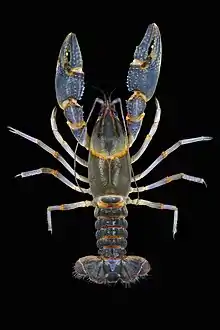| Banded mudbug | |
|---|---|
 | |
| Banded mudbug, Lacunicambarus freudensteini, holotype | |
| Scientific classification | |
| Domain: | Eukaryota |
| Kingdom: | Animalia |
| Phylum: | Arthropoda |
| Class: | Malacostraca |
| Order: | Decapoda |
| Suborder: | Pleocyemata |
| Family: | Cambaridae |
| Genus: | Lacunicambarus |
| Species: | L. freudensteini |
| Binomial name | |
| Lacunicambarus freudensteini Glon, 2020 | |
Lacunicambarus freudensteini, the banded mudbug, is a species of North American burrowing crayfish found in Alabama and Mississippi.[2][3]
Description
The banded mudbug is a small (maximum size: ~2–2.5 inches) primary burrowing crayfish. This crayfish is typically blue overall with orange highlights on its joints, although rare bright blue and pink specimens have also been collected.[3] Because of this species' exceedingly small range and overall rarity, this species is ranked as S1 (Critically imperiled) in both states where it occurs (Alabama and Mississippi) and has a NatureServe global rank of G1 (Critically imperiled).[1]
Range
The banded mudbug is a very rare species known only from nine sites in Mobile County, Alabama and Jackson County, Mississippi.[3]
Habitat
The banded mudbug is typically found burrowing in open, non-sloping grasslands with a shallow claypan.[3]
Etymology
The banded mudbug was named after Dr. John Freudenstein.[4] The common name "banded mudbug" refers to the orange bands on the dorsal side of this species and as the fact that it is a primary burrowing crayfish (often called "mudbugs").[3]
References
- 1 2 "Lacunicambarus freudensteini (Banded Mudbug)". NatureServe. Retrieved 2022-01-24.
- ↑ "Lacunicambarus freudensteini (Banded Mudbug)". iNaturalist. Retrieved 2022-01-24.
- 1 2 3 4 5 Glon, Mael G.; Adams, Susan B.; Loughman, Zachary J.; Myers, Greg A.; Taylor, Christopher A.; Schuster, Guenter A. (2020). "Two new species of burrowing crayfish in the genus Lacunicambarus (Decapoda: Cambaridae) from Alabama and Mississippi" (PDF). Zootaxa. 4802 (3): 401–439. doi:10.11646/zootaxa.4802.3.1. PMID 33056041.
- ↑ "Ohio State-Dr. John Freudensein". Ohio State University Department of Evolution, Ecology and Organismal Biology. Retrieved 2022-01-24.
